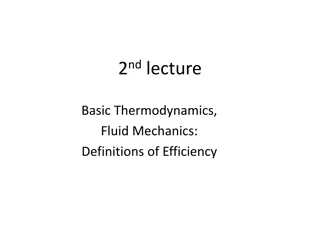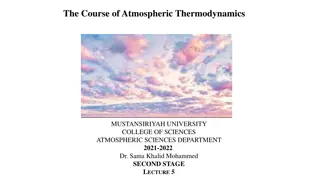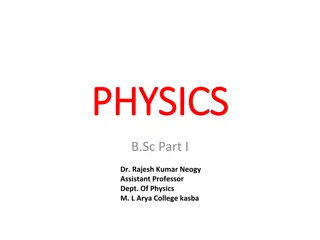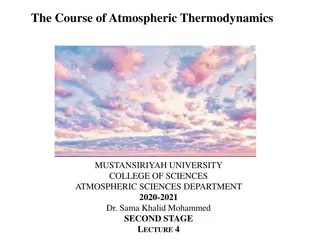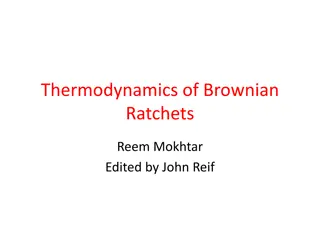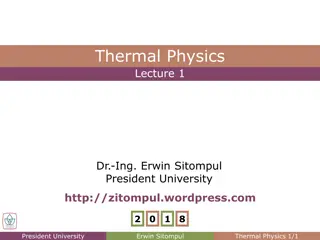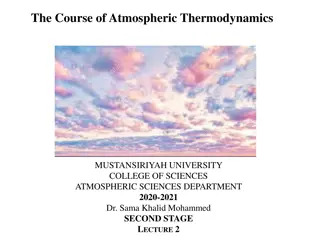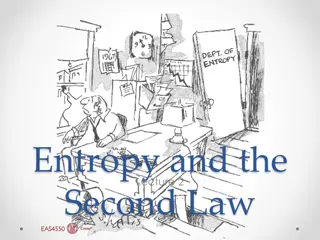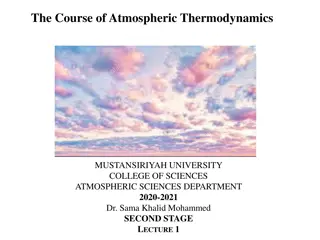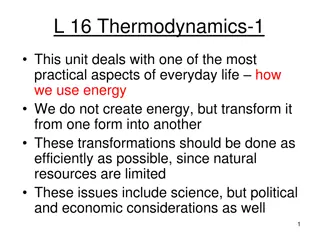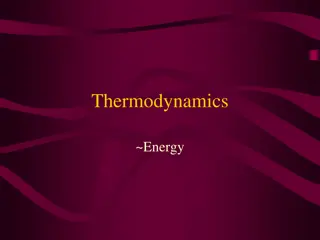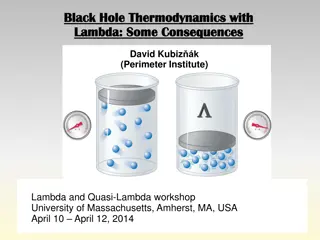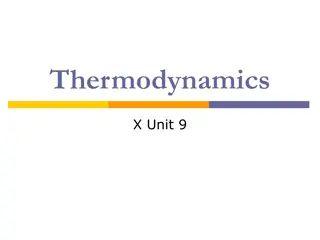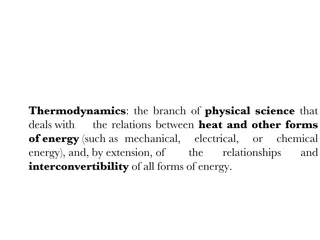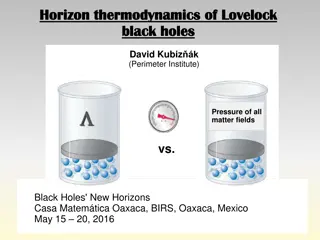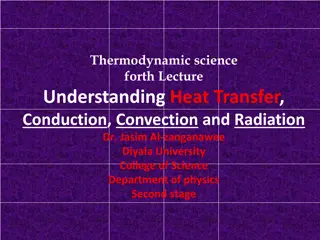Understanding Atmospheric Thermodynamics in Second Stage Lecture
Explore key concepts in atmospheric thermodynamics, including condensation level, free convection level, and the use of thermodynamic diagrams. Learn about the process of condensation, stability levels in the atmosphere, and the significance of free convection in weather patterns. Discover why thermodynamic diagrams are essential for calculations like determining condensation levels and free convection temperatures.
- Atmospheric Thermodynamics
- Condensation Level
- Free Convection
- Thermodynamic Diagrams
- Weather Patterns
Download Presentation

Please find below an Image/Link to download the presentation.
The content on the website is provided AS IS for your information and personal use only. It may not be sold, licensed, or shared on other websites without obtaining consent from the author. Download presentation by click this link. If you encounter any issues during the download, it is possible that the publisher has removed the file from their server.
E N D
Presentation Transcript
The Course of Atmospheric Thermodynamics MUSTANSIRIYAH UNIVERSITY COLLEGE OF SCIENCES ATMOSPHERIC SCIENCES DEPARTMENT 2020-2021 Dr. Sama Khalid Mohammed SECOND STAGE LECTURE 5
THIS LECTURE INCLUDING THE FOLLOWING ITEMS CONDENSATION LEVEL. FREE CONVECTION LEVEL. THERMODYNAMIC DIAGRAMS.
CONDENSATION LEVEL Suppose an unsaturated (but humid) air parcel is somehow forced to rise from the surface, as the parcel rises, it expands, and cools at the dry adiabatic rate until its air temperature cools to its dew point. At this level, the air is saturated; the relative humidity percent, and furthers lifting results in condensation and the formation of a cloud. is 100
CONDENSATION LEVEL The surface where the cloud first forms is condensation example 1 km) , notice that above the condensation level, the rising saturated air cools at the moist adiabatic rate. Notice also that from the surface up to a level near 2 km, the rising; lifted air is colder than the air surrounding it. The atmosphere up to this level is stable. elevation above the called level the (for
CONDENSATION LEVEL During lifting the mixing ratio w and potential temperature of the air parcel remain constant, but the saturation mixing ratio ws decreases until it becomes equal to w at the LCL. Therefore, the LCL is located at the intersection of the potential temperature line passing through the temperature T and pressure p of the air parcel, and the wsline that passes through the pressure p and dew point Tdof the parcel
FREE CONVECTION LEVEL Due to the release of latent heat, the rising air near 2 km has actually become warmer than the air around it. Since the lifted air can rise on its own accord, the atmosphere is now unstable. The level in the atmosphere where the air parcel, after being lifted, becomes warmer than the air surrounding it, is called the level of free convection.
Why We Use Thermodynamic Diagrams? They are used to graphically display the relation between two of the thermodynamic variables T, V, and p, Process lines represent on the diagram. This is done through processes lines which represent specific thermodynamic processes, and each chart contains five sets of lines including: Isotherms , Isobars , Adiabats, Pseudoadiabats(moist adabats), Saturation moisture lines. We used them for basic calculation such as condensation level, temperature of free convection.
Why We Use Thermodynamic Diagrams? When an air parcel undergoes a reversible process, the succession of states is represented on the thermodynamic diagram by a curve. A cyclic process is represented by a closed curve. On some charts the area so enclosed is directly proportional to the work done in the process.
Isobars and Isotherms in a Thermodynamic Diagrams The pressure and temperature uniquely define the thermodynamic state of a dry air parcel of unit mass at any time. The horizontal lines represent isobars and the vertical lines describe isotherms.
Dry Adiabats and Moist or Pseudo Adiabats Dry Adiabats lines represent the change in temperature that an unsaturated air parcel would undergo if moved up and down in the atmosphere. Pseudo or moist Adiabatic Lines usually curves portray the temperature changes that occur upon a saturated air parcel when vertically displaced. Saturation adiabats appear on the thermodynamic diagram as a set of curves with slopes ranging from 0.2C /100 m in warm air near the surface to that approaching the dry adiabats (1C /100 m) in cold air aloft, why?
Isohume Mixing Ratio Lines These lines (also called saturation mixing ratio lines or isopleths) uniquely define the maximum amount of water vapor that could be held in the atmosphere (saturation mixing ratio) for each combination of temperature and pressure. These lines can be used to determine whether the parcel were saturated or not.
What are the properties of a Useful Thermodynamic Diagrams? The diagrams are such that equal area represents equal energy on any point on the diagram. A useful thermodynamic diagram should have the following general properties The area enclosed by a cyclic process should be proportional to the work done during the process. As many of the process lines as possible should be straight. The angle between the isotherms and adiabats should be as close to 90 as possible.
FYI: How to create a diagram? We can create a diagram with area proportional to work using the p- diagram. Since work per unit mass is defined as dw = - p d , the area on a p- diagram is proportional to work. But this diagram is not very useful for meteorologists because The angle between isotherms and adiabats is very small Process lines aren t very straight Volume is not a convenient thermodynamic variable for meteorology.
How to create a Useful diagram for Meteorologist? By using (T and p ) as the thermodynamic variables, but we have to find a way of setting up the axes of our diagram so that area will be proportional to work. What are the True thermodynamic diagram? Because equal area represents equal energy on any point on the diagram, a true thermodynamic diagram has an Area and Energy
FYI: How to create a Useful diagram for Meteorologist?
What are the Types of Diagrams? Some of the types of the Thermodynamic Diagrams are: Emagram Tephigram SkewT/Log P diagram (modified emagram) Psuedoadiabatic (or St ve) diagram
What is The EMAGRAM? What are the Properties of its Lines? The diagram) is created by letting X = T, and by using the equation of state for dry air with some mathematical processes we get the diagram axes: X=T , Y= - Rd ln P The properties of the lines in Emagram are: Dry Adiabats are slightly curved, concave upward, Pseudoadiabats are curved convex upward, Isotherm adiabat angle varies with axis scale, but is usually about 45 . Area denotes total work done in a cyclic process w = -Rd T dlnP, and this it represent a true thermodynamic diagram. emagram (energy-per-unit-mass isotherms Rd lnP T
Pseudo-adiabatic chart we can look at the following equation of potential temperature graphically, then we will get e.g., the Pseudo-adiabatic chart . 0 286 . 0 0 286 p p 0 p = = . 0 286 T p T Re-arrange: So if you plot: p0.286 on y-axis, T on x-axis For a constant , (p00.286/ ) is also a constant, so the graph yields a straight line with gradient given by (p00.286/ ), and passing through T=0 and p=0
Pseudo-adiabatic chart Earth s atmosphere y-axis is linear for p0.286 also linear for ln(p)
Pseudo-adiabatic chart isotherms are vertical and dry adiabats (constant ) are oriented at an acute angle relative to isotherms. Because changes in temperature with height in the atmosphere generally lie between isothermal and dry adiabatic, most temperature soundings lie within a narrow range of angles when plotted on a pseudo-adiabatic chart. Advantage: we can follow each line and determine graphically temperature at any pressure, assuming adiabatic expansion / compression. Disadvantage: Everything happens in small region of the chart.
Skew T ln P chart This restriction is overcome in the so-called skew T -ln p chart, in which the ordinate (y) is ln p and the abscissa (x) is x=T+(constant)y = T-(constant)ln p So y=(x T)/(constant) and for an isotherm T is constant, the relationship between y and x for an isotherm is of the form y = mx + c, where m is the same for all isotherms and c is a different constant for each isotherm. Therefore, on the skew T - ln p chart, isotherms are straight parallel lines that slope upward from left to right. y = -RlnP x = T + klnP
Skew T ln P chart The scale for the x axis is generally chosen to make the angle between the isotherms and the isobars about 45 , as depicted schematically in Fig. Note that the isotherms on a skew T - ln p chart are intentionally skewed by about 45 from their vertical orientation in the pseudoadiabatic chart (hence the name skew T ln p chart).
Skew T ln P chart From (eq 1), the equation for a dry adiabat ( constant) is ln P = (constant) ln T + constant Hence, on a ln p versus ln T chart, dry adiabats would be straight lines. Since ln p is the ordinate on the skew T ln p chart, but the abscissa is not ln T, dry adiabats on this chart are slightly curved lines that run from the lower right to the upper left. The angle between the isotherms and the dry adiabats on a skew T ln p chart is approximately 90 . Therefore, when atmospheric soundings are plotted on this chart, small differences in slope are more apparent than they are on the pseudoadiabatic chart. y = -RlnP x = T + klnP temperature
What are all the lines on the skew T-ln p chart? isobar isotherm dry adiabat saturated adiabat saturation mixing ratio
CHECK OUT THIS SITE FOR SKEW T- ln P CHART https://www.weather.gov/jetstream/skewt


